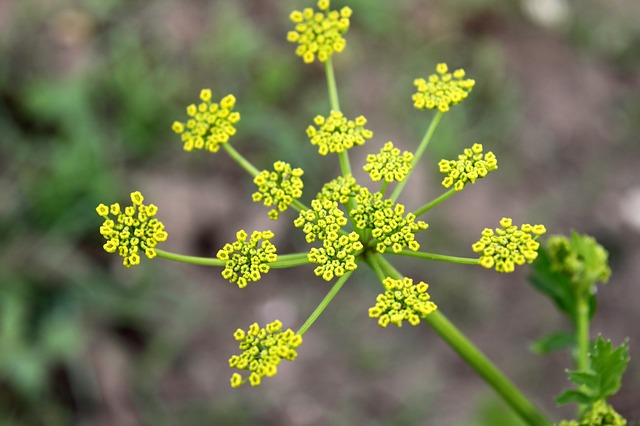 |  |  |   |  |
 |  |  |
Wild Parsnip- a biennial herb with a fleshy and juicy root. The stem is erect, grooved and faceted, hairy, from 30 cm to 3 m tall. The leaves are tufted on long petioles, shiny on top, covered with soft, thick hairs on the bottom. Leaf lobes sharply toothed and deeply cleft. In hot weather, essential oils are released from the leaves.
Wild Parsnip begins to bloom in July and continues until September. The flowers are bisexual, correct, small, yellow, arranged in compound cymes consisting of 8-12 rays.
The fruit is an oval dicot, which splits into two parts when ripe. Wild Parsnip is a crop derived from a wild form of Wild Parsnip . The main difference is in the rhizome - Wild Parsnip is sweet. The plant has a weak but pleasant aroma.
In the first year of life, Wild Parsnip forms a rosette of leaves and a juicy rhizome. Flowering begins in the second year in July-August. The fruits ripen in early autumn.
The seeds are compressed, round-elliptical in shape, yellow-brown in color. Wild Parsnip likes fertile, well-drained soil. If you want to grow it, you need a warm and sunny place with improved soil. Propagated by seeds. Young seedlings withstand frosts well. It is interesting that this plant has no natural enemies - insects and is not demanding on growing conditions.
Meadow parsnip root, stems with leaves and seeds are used for medicinal purposes. Only harvest parsnips that have been sown, wild parsnips are toxic and should not be used for culinary or medicinal purposes. Biologists often refer to the wild form as Pastinaca silvestris, but it is more of a variety than a different plant. Wild parsnip differs in the size of the rhizome (it is often the size of a parsley root), it is bitter, and it is often already empty, having given all its strength to the production of seeds.
A high-quality rhizome is distinctly white, the whiter the sweeter, firm, without cracks, injuries and dark spots. When choosing rhizomes, focus on medium-sized rhizomes. Large ones may be veined inside. More details are distinctly sweeter.
Wild Parsnip are harvested in late autumn, but safety measures should be observed even then. In hot weather, the leaves produce essential oils that can burn the skin. The rhizomes are not washed, only the remains of the soil are cleaned. The rhizomes can be perfectly stored covered with moist soil, in a dark and cool place. For drying, the rhizome is cut into straws and dried at a temperature not exceeding 50C. The drug is stored in airtight containers for up to 1 year.
Wild Parsnip seeds are harvested when fully ripe. Cut off everything, dry, then grind off the seeds. Fruits and seeds are stored for 3 years in airtight containers.
Wild Parsnip stalks with leaves are harvested during flowering. Spread on a sheet of paper and dry in a well-ventilated place, in the shade.
Fresh Wild Parsnip root contains 10% carbohydrates, 4% starch, up to 0.5% vegetable fat, <3.4% essential oil, pectin ~7%, pantothenic acid and nicotinic acid, riboflavin, carotene, fiber, thiamin, ascorbic acid, vitamin PP, B2, minerals (potassium, phosphorus, magnesium, zinc, etc.).
Wild Parsnip seeds contain furocoumarins (xanthotoxin <1%, fondin, bergapten), coumarins, flavonoid glycosides, vegetable fats (<10%). Octylbutyl fatty acid ester is found in the essential oil (3.5%), which gives the plant a peculiar, pleasant smell. Fresh milkweed contains vitamin C, carotene, riboflavin, thiamin, folic acid, essential oil, furocoumarins.Medicinal significance
As an experiment, European scientists extracted furocoumarins from the plant and they also turned out to be the most pharmacologically active substances of this plant. It has been proven that furocoumarins have pronounced antispasmodic properties, as well as photosensitizing properties - the ability to increase the sensitivity of the skin to the sun. These active substances help to depigment the skin, for example in people suffering from vitiligo. Today's medicine uses Wild Parsnip preparations for the treatment and prevention of various heart diseases.
Laboratory studies also showed good results that the plant is able to improve the digestive process, strengthen capillary walls, stimulate expectoration and have an antispasmodic effect. In addition, the plant also has dietary effectiveness. The rhizome has diuretic properties, it is rich in potassium, which helps to remove the excess solution from the body, freeing it from edema.
Wild Parsnip rhizomes and leaves are used in folk medicine. Aqueous infusions and decoctions of rhizomes are drunk as an expectorant, used to expel sputum in cases of bronchitis, pleurisy, pneumonia and tuberculosis. It is used as an antispasmodic agent in case of various pains - digestive tract, kidney and liver colic, gout.
Grated, fresh rhizome is also able to reduce pain, it is used in gallstone disease. Wild Parsnip is an excellent tonic that helps strengthen the body after illness.
The rhizome is used as a diuretic in case of kidney stone disease and edema. Water settling has an arousing effect and activates sex hormones. The infusion from the rhizomes of the Wild Parsnip has a calming effect, strengthening the capillary wall, and removing spasm of blood vessels.
Wild Parsnip is used for muscle spasms, neurosis, angina, hypertension and insomnia. The plant also acts as a body-strengthening, immunomodulating agent.
The alcohol extract of the rhizomes and the leaves of the plant helps to get rid of hallucinations and bad mood.
In folk cosmetology, Wild Parsnip decoctions and juice are used against baldness, it activates the activity of hair follicles. The decoction is applied to patches of scabies and also treats vitiligo.
